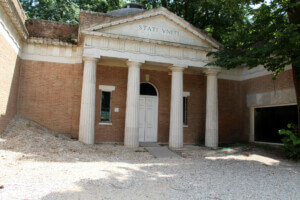There is often a barrier to entry when it comes to talking about Detroit. No matter how empathetically one approaches the subject, there is the distinct possibility of being accused of insensitivity. Detroit has been through, and continues to go through, some of the most difficult urban issues in the country. And, naturally, many Detroiters are downright tired of outsiders coming in and proposing “solutions” to the city’s ills. So when it was announced that the United States Pavilion for the 15th Venice Architecture Biennale would focus on the city, it was not surprising that some would take issue.
The United States Pavilion is explicitly about Detroit. The pavilion is organized by the University of Michigan Taubman College of Architecture and Urban Planning and curated by Mónica Ponce de León, former dean at Michigan and current dean at Princeton University, and Cynthia Davidson, editor of the journal Log. Titled the Architectural Imagination, the two curators charged 12 design firms to speculate on four sites throughout Detroit—the former Packard Automotive Plant, the U.S. Post Office on Fort Street, and city-owned sites in Mexicantown and the Dequindre Cut. The firms range from lesser-known talent to well-known names like Stan Allen and Greg Lynn. All firms were given free rein to imagine what program and form should go on their sites. They met with city and community representatives to discuss their projects and gain a better understanding of the sites. Overall, the exhibition is fairly typical of what one might expect to see in a show about architecture, with large models and drawings filling the pavilion. (See our review of the pavilion and de León and Davidson’s response.)
Before the exhibition opened, well before any of the designs were revealed, criticism was leveled against the show. Most notably this critique came from a group called Detroit Resists. Remaining anonymous, Detroit Resists released a statement linking architecture, and the institutions that generally support building, to some of the systemic issues that plague Detroit: mass water shutoffs, evictions, gentrification, and spatial racism. The group accused the organizers, and indirectly the participating firms, of political indifference.
And Detroit Resists was far from alone in its skepticism, if not in its fervor. The conversation of Detroit and its relationship to contemporary design and
architecture is a popular one. The U.S. Pavilion is not the first, and will not be the last, to speculate on Detroit. The general criticism of any design proposals
produced for the city is that the egoism of the designers and their lack of connection to the city mean that they could not possibly contribute to the betterment of the people of Detroit.
One could not have a conversation about the possible designs without also having a conversation about whether it was even appropriate to talk about architecture and Detroit together. Just weeks before the Biennale opening, New York’s New Museum hosted a weeklong workshop titled Ideas City in Detroit. The workshop brought together Detroiters, other Americans, and international designers and architects to discuss and think about the city. Similarly, the U.S. Pavilion participants engaged the community in conversations throughout the design process. A great deal of the conversation in that week, and in the concluding public forum, revolved around the role of outsiders in the reimagining of Detroit. Ideas City made very few proposals for the city, though. Instead, it reserved most of its actions to discussion and listening. By most accounts—from Detroiters and others—the event was productive.
Yet the skepticism of the U.S. Pavilion is not what is at issue. Rather, it is the preemptive cynicism and dismissive posture that came with that skepticism. To say that architecture, from within or from without Detroit, is inherently a negative for the city, is to negate any possibility of it being anything else. Having a serious conversation about architectural ideas means admitting that Detroit is not a war-torn wasteland, because it isn’t, and engaging with architects means accepting Detroiters as urbanites as much as any other city dwellers.
Now that the pavilion is open, we are able to look at the projects and judge whether they are doing the harm of which they have been accused. Proposals range from complex abstractions of information gathered from the community to complex postindustrial tech complexes. Others take on community gathering spaces, and yet others reimagine infrastructural amenities, such as urban farm space and material reclamation. Now is the time to carefully read the projects and decide whether they live down to the allegations of cultural insensitivity that were laid against them.
Detroit, like all cities, is inseparably linked with architecture, old and new. No matter how badly, or well, things are going, architecture is part of the city-making conversation. It will never heal the ills of any city. It is not a solution or a means to specific ends. Yet to dismiss the possibility of architecture is to close the conversation on the built environment. And though it is naive to think that architecture won’t be used for nefarious purposes, it is cynical to think that it has to be used as such. Where exactly it fits into improving the postindustrial city, or the racially segregated city, is still unclear. But there are people working on it.
The U.S. Pavilion, The Architectural Imagination, will be open from May 28 through November 27 at the 15th Venice Architecture Biennale in Venice, Italy. More information on Detroit Resists can be found at detroitresists.org










